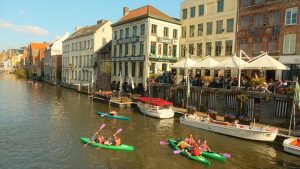Groovy getaway to glorious Ghent
Another day, another day trip, this time from Bruges to Ghent! It was a toss-up between Ghent and Antwerp, but with Ghent being described as smaller (it’s a city of 250,000), I figured it would be a nice contrast to our Brussels day trip.
The train was 7.80 EUR ($10) round-trip, but this fare only applies on the weekends. Otherwise it’s 13.60 EUR ($17). The trip takes about 30 minutes, followed by a 30 minute walk to the center of town. We could have also disembarked at the St. Pieters station and taken a tram to the city center, but it was a beautiful day, so we decided to walk instead.
Ghent has nearly 100 public toilets, along with a map of where they’re all located! Great for someone like me who drinks a lot and has a small bladder, so it was pretty much a moral obligation to try one out.
The most beautiful part of town consists of Graslei and Korenlei , the two banks on either side of the Leie River. Like Bruges and Amsterdam, you can take a canal tour down the Leie, but we didn’t have too much time and had just done a canal tour of Bruges, so we decided to skip it and get our bearings by wandering aimlessly for a while, soaking in the sights:

Gravensteen — a massive castle smack dab in the middle of town! A full walk-thru video of the castle, including its torture museum, is the subject of my next video/article.
Het Groot Vleeshuis (The Great Butchers’ Hall), which was built in the 15th century to house a meat hall and indoor market. Those are still there, but now there’s a restaurant situated under the giant hams hanging from the ceiling of the meat hall. The menu looked good, but as a vegetarian, there was no way I was going to be able to eat there without losing my appetite.
Werregarenstraat — a two-block alleyway linking Hoogpoort and Onderstraat that is completely covered with graffiti. It was setup as part of the Ghent Festivities festival in 1995 and is one of the few locations where the city officially allows graffiti. Anyone can paint over anything so it’s constantly changing, but the code is to respect work that’s finer than your own.
After seeing the sights, we figured it was time to get down to the important stuff: eating and boozing. First up was the food, which we found at the small and off-the-beaten path restaurant Soup’r, specializing in… soup. This place was jam-packed and is obviously a local favorite, and one taste of the soup explained why: Best. Soup. Ever! Lots of hearty vegetarian, vegan, and meat-filled soups and sandwiches made the three of us very happy after many miles of walking. Included with the soup were a few weird large violet jelly bean things called cuberdons that were also being sold from carts all over town. None of us liked them – must be a Flemish acquired taste. Be aware that Soup’r only takes Belgian debit cards, so make sure you bring some Euros.

I was actually a bit surprised by our first booze stop, which was at Dreupelkot, a legit jenever bar serving over 200 varieties of this tasty grandfather of gin. I’d only had jenever in The Netherlands and assumed it was local to that area, but it didn’t occur to me that it would also be popular in with Dutch population of Ghent. Turns out that by decree of the EU, only liquor made in Belgium, the Netherlands, and four French and German regions can legally be called jenever. Regardless, the korenwijn (a malty style) I had was lovely.
Finally, we ended our drinking at Waterhuis ann de bierkant (Waterhouse on the beerside) a scenic and historic canal-side bar which serves 165 beers, including 3 house beers that you can only find on draft here. I had a glass of the house Gandavum, a dry-hopped 8% Belgian Ale, which I found refreshingly crisp and dangerously drinkable considering the high alcohol content.
While doing my research for the trip, there seemed to be a lot of “Ghent vs Bruges” discussions, and after visiting them both, I’d say that they’re very different, but that both are definitely worth a visit. Bruges is smaller and prettier and quainter and more “magical”, but also very crowded and touristy on the weekends. Ghent, on the other hand, was lively on the weekend we visited, but didn’t feel too crowded. It has plenty of large open spaces, and apparently when the weather is nice there are musicians performing on every corner, from buskers all the way to large brass bands. And, since they’re only 30 minutes from each other, there’s really no good reason not to visit both!

Leonard Kinsey is the owner of Bamboo Forest Publishing, and the bestselling author of “The Dark Side of Disney”, the Anarchist Cookbook of Disney travel guides. He has lived in Baltimore for over 15 years, and enjoys drinking craft beer in unique places, eating nachos and pizza, listening to 80s hair metal, and arguing about Star Trek minutia, often all at the same time. Watch out ladies!
